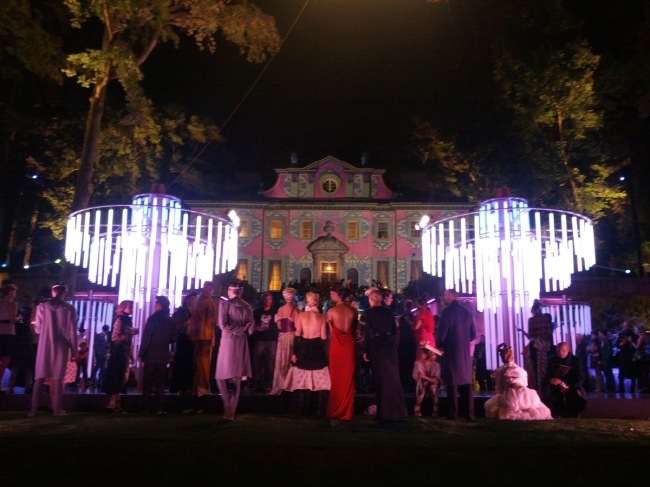Production Designer Phil Messina On 'Catching Fire' and 'Mockingjay'
 Molly
Molly  Wed, January 15, 2014
Wed, January 15, 2014 
The Hunger Games director Gary Ross brought Phil Messina on board as Production Designer, and he remains with the franchise, creating the world in Catching Fire as well as both Mockingjay movies, currently in production. He recently spoke with FlickeringMyth.com about the films, some of the challenges, and what it was like working with Francis Lawrence who "has become a dear friend of mine."
How it all started:
Gary called me which was in the middle of night my time and said that he was going on this film called Hunger Games [2012]. I had never heard of it. Gary was probably the most excited about it than I had heard of any one director and he had the script emailed to me. I had to go work in the morning but I read it all night. Suzanne [Collins] was part of the process the entire time so there wasn’t a dichotomy between script and book. When questions came up in our work about how things were organized or what things should look it we often went back to the book. In fact we still do. I’m working on Mockingjay 1 [2014] and 2 [2015] right now so at the end of this I’ve would have done all four Hunger Games films. I have dog-eared pages of all three books in my office that we’re constantly referring back to try to keep it straight.”

Working with director Francis Lawrence on Catching Fire:
“When I found out about the second film Gary was going to direct it and he was the one who asked me back,” recalls Phil Messina. “When he decided not to do the film it was an odd couple of weeks where Producer Nina Jacobson was persuasive in saying, ‘We want the continuity since we’re bringing in an unknown entity at this point.’ They hadn’t hired a director yet. I was caught by surprise and they were all reacting in real time. I was literally reading the movie headlines a couple times a day to see who was in the lead to do our film. I had not worked with Francis [Lawrence] before nor had any contact with him. I took our first meeting as if I was interviewing for the job. If Francis wanted to go in a different direction or it wasn’t going to work out personality wise I would have bowed out. We had a wonderful connection and he has become a dear friend of mine.”
 Photo courtesy litegear.com
Photo courtesy litegear.com

On creating Panem:
“There are a lot of different ways you can go,” explains Phil Messina. “There is the Star Trek, Star Wars and Oblivion that's high tech futuristic which is an amazing look. But with ours it was important for it to be accessible, and feel like a world that could easily develop in the not so distant future. Suzanne described this world as having no satellites or Internet. It’s not so futuristic, but a parallel society that would have developed given a different set of circumstances. That’s what I found interesting in the world. How do things develop if XYZ...? Those are some of the factors that we’re dealing with every day.” Cities don’t grow from one place. What we tried to bring to it was a visual harmony of a singular idea but also things are built at different times. It doesn’t all go up in the same five or ten years. It had developed over a certain amount of time. In Catching Fire we have more of the Capitol shown than in Hunger Games, but in Mockingjay, especially in the second film, it's like being on the streets of the Capitol. We’re using some locations in Europe, especially in Paris and Berlin. We tried to use places that felt architecturally relevant to our film and also felt real. One thing that Francis wanted was to be on real streets; he didn’t want to be on the back lot with fake buildings so we are in a lot of real locations and I find that exciting.”
On the Districts:
“Every district has a specific purpose which has a specific resource that serves the capital,” states Phil Messina. “Katniss [Jennifer Lawrence] is from the mining district which Suzanne wrote as being in the Appalachian Mountains so we naturally drew from the coal mines from West Virginia." The production designer drew upon his own childhood. “For the textile district I grew up in a mill town called Lawrence, Massachusetts which at the turn of the last century was the textile centre of the world. In Catching Fire when we had to create the textile district for a brief scene I knew exactly where to draw from. The transportation district we used a lot of trains. We tried to stay mostly in the U.S. and not to draw from too many European influences. We tried to make it American feeling. Logging and lumber is from the Pacific Northwest. Suzanne had marked out a map of Panem where each of these resources came from and were based on American history. It became easy to think of the next step and start creating the visuals for them.” (insert personal freak out - WHERE IS THIS MAP??)

On Catching Fire:
"It looks beautiful and the world looks real. The shot selections were great and it tells a story.” Messina adds, “I’m proud about the work I did with Gary on the first one and I’m proud of the work I’ve done on Catching Fire with Francis. I’ve seen Catching Fire several times already and it’s fantastic. I’m glad to continue to be part of this franchise.”
Read the rest of the really interesting interview HERE. Phil talks more about the Hunger Games weapons, working with CG and shooting in the jungle.







Reader Comments